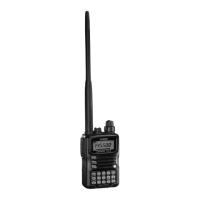
 Loading...
Loading...
Do you have a question about the Yaesu VX-6R and is the answer not in the manual?
| Frequency Range (Transmit) | 144-148 MHz, 222-225 MHz, 430-450 MHz |
|---|---|
| Waterproof Rating | IPX7 |
| Antenna Connector | SMA |
| Frequency Range (Receive) | 0.5-999 MHz |
| Modes | FM |
| Channels/Memory | 900 |
| Display | LCD |
| Receiver Type | Superheterodyne |
Detailed functions of each key on the transceiver keypad.
Steps for installing the FNB-80LI rechargeable battery pack.
Steps to turn the transceiver on and off.
Procedure for setting the squelch level to reduce background noise.
How to switch between different frequency bands supported by the radio.
Method for entering frequencies directly using the numeric keypad.
Explains methods for tuning frequencies using the DIAL knob or keypad.
How to initiate frequency scanning to find active signals.
Basic steps for transmitting signals using the PTT switch.
How to select different transmit power output levels.
How to lock the keypad and controls to prevent accidental changes.
Setting squelch based on signal strength (S-meter level).
Explains default repeater shift values for different bands.
Manually setting the repeater shift direction (plus, minus, simplex).
How to automatically apply repeater shifts based on band.
Setting up CTCSS tones for repeater access and selective calling.
Setting up Digital Coded Squelch (DCS) for enhanced selective calling.
Procedure for storing frequencies and settings into memory.
How to store separate transmit and receive frequencies for repeaters.
Organizing memories into 24 banks for easier management.
How to retrieve stored frequencies from memory.
Direct access to up to ten favorite frequencies via numeric keys.
Configuring how the scanner resumes after finding a signal.
Scanning across frequencies in VFO mode with adjustable bandwidth.
Scanning through stored memory channels using various modes.
Setting up a list of preferred channels for scanning.
Scanning within user-defined sub-band limits.
Checking a priority channel periodically while operating on another.
Storing frequencies to be skipped during VFO scanning.
Marking memory channels to be skipped during memory scanning.
Selecting between single sweep or continuous sweep modes.
Setting up paired CTCSS tones for paging and selective calling.
Enabling the EPCS feature for paging and selective calls.
Using the dedicated emergency channel and its features.
Configuring EAI mode (interval/continuous) and transmit time.
Using EAI to find an incapacitated operator.
Automatically transmitting callsign in emergencies.
Steps to enable the Emergency Automatic ID feature.
Setting up and using the ARTS™ system for range confirmation.
Activating the Internet Connection feature for WIRES™ nodes.
Accessing Internet Link Systems using DTMF strings.
Restoring transceiver to factory defaults by resetting the microprocessor.
Resetting Set Mode items to their factory defaults.
Enabling/Disabling the Emergency Automatic ID (EAI) Feature.
Setting EAI operating mode and transmit time.
Enabling/disabling Enhanced CTCSS Paging & Code Squelch.